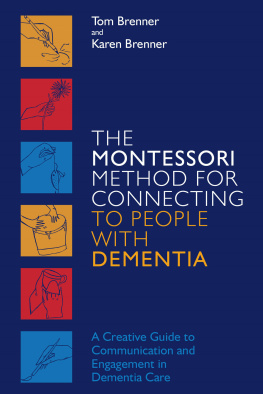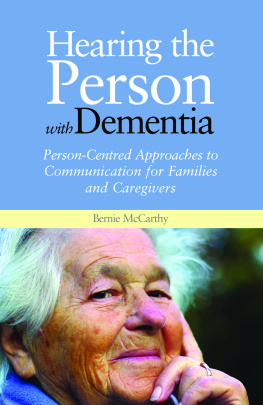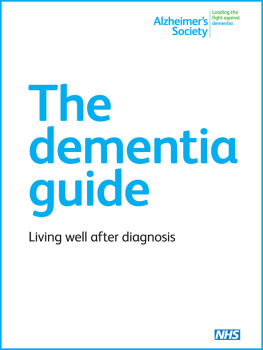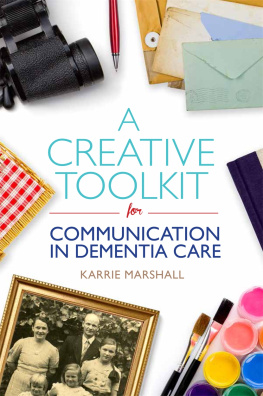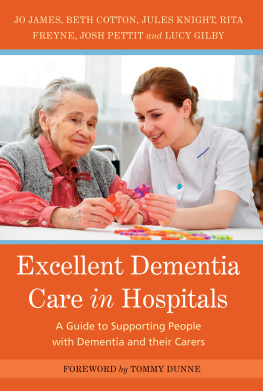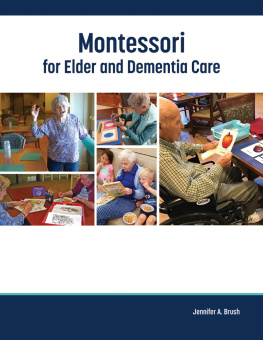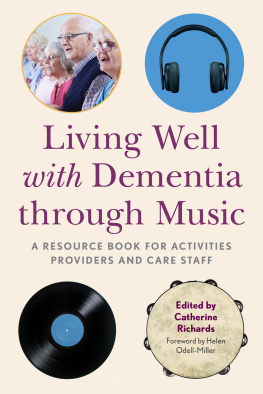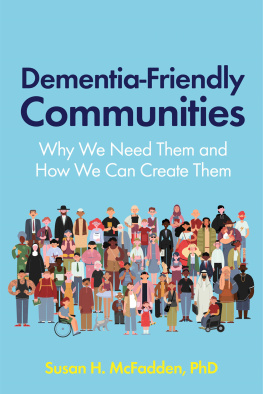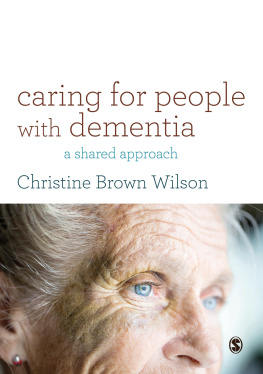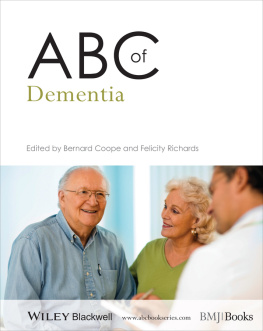
The Montessori Method
for Connecting to
People with Dementia
A Creative Guide to Communication
and Engagement in Dementia Care
Tom Brenner
and Karen Brenner

Jessica Kingsley Publishers
London and Philadelphia
Contents
Chapter One
Introduction: Karen Brenner and Tom Brenner
Karens story
When I first met him, he was a young man with only two speeds, working flat out or sound asleep. He has been a drummer, a machinist, a medic, and is now a gerontologist. He can repair anything that breaks, from a washing machine to a heart. He is the person who will always, always, come to the aid of others. (The American Red Cross honored him in 2010 as Hero of the Year.) He is a wonderful storyteller with a wild streak, a lover of jazz and art. He is also hot-tempered, impatient, opinionated, and demanding, with very high expectations for himself and for others.
That is why I was so shocked the first time I saw him interacting with a person who has dementia. I was so used to the impatient, quick, restless man. Who was this person of patience, quiet, and calm? When he works with people who are living with dementia, he slows everything down, his speech, his movements, and his expectations. He sits quietly with people, waiting patiently for them to form their thoughts, never interrupting, never showing the slightest sign of being bored or restless. His name is Tom, and he is my husband.
Reaching the unreachable
Tom and I began working with people who have dementia 20 years ago. At that time, we had been married for many years, had raised our children, mourned the loss of our parents, and supported each other in our mutual return to graduate school. We had been through a lot. I thought I knew him pretty well after all of these years together and all of the experiences we had shared. I was wrong. I was in for a complete shock when we began working together, building our memory support program.
With his history and his personality, I was expecting Tom to experience a long and difficult learning curve working with people who have dementia. Again, I was wrong. The term like a duck to water might have been coined to describe Toms introduction to the world of dementia. From the first moment, he was perfectly at home, perfectly at ease, perfectly happy working with, talking to, and just being with people who are living with dementia.
There is a kind of magic that happens when Tom begins his work. I have watched him now for years and am still amazed by his ability to reach people. Our memory support program gives Tom (and everyone using it) many tools to interact successfully with people who have dementia. In Toms hands, these tools become a powerful device to reach people who may seem unreachable.
When we walk into a long-term care home, a memory enhancement center, an adult day care facility, we often meet groups of people who are just sitting, staring into space, seemingly not aware of their surroundings or each other. Tom will sit down with this group and in ten minutes they are talking and laughing, or singing, or playing drums together. I have seen this happen over and over and over for years, and every single time I am moved to tears.
Applying Montessori methods to dementia care
For me, the transition from being a Montessori teacher working with children to interacting with elders was not so easy. I was, quite frankly, frightened of people who had dementia. I grew up in a family for whom scenes of any type were an anathema. The idea of interacting with people who might shout at me or cry or grab me was abhorrent. But Tom had done extensive research on person-centered dementia care and was convinced that the work I was doing with children in a Montessori classroom could be translated into a program for people living with dementia.
I had been working for many years in an inclusion program with children who are deaf. The highly organized, visual, stimulating Montessori environment proved to be perfect for children who couldnt hear and had difficulties in communication. I could intellectually understand the parallels that Tom drew from the prepared environment of the Montessori classroom and a good, person-centered care home. But I was scared.
I well remember the day that I decided I just couldnt do this work with Tom. We had been volunteering at a long-term care home on Saturday afternoons. We would bring in different Montessori materials and exercises to share with the people living in the home. The older people seemed to be drawn to the beautiful materials just as the children were. I could see that Tom was on to something, that there was an obvious interest in the Montessori work. The older people would watch us patiently and then try the work themselves. We introduced flower arranging, flags of the world, fabric matching, any Montessori material that we thought might be helpful and interesting to the people in the care home. But there was one resident who did not like our being there. She would shout at us, tell us to go away, that no one wanted us there, and that we were interfering with people and bothering them. She would raise her arm as if she was going to strike us, but she never did. That didnt matter to me; Bridget really frightened me.
So that Saturday afternoon, as we stood just outside the door of the care home and the autumn leaves swirled around our feet, the cold wind snatching our voices away, I told Tom,
I dont want to go back today. Im afraid of some of those people. You know how much I hate scenes and last Saturday Bridget yelled at us again. I just froze when she took off her slipper and started hitting that other woman on the head with it. You knew what to do, how to calm her down. I dont know what Im doing here. Im just a Montessori teacher. Youre the gerontologist, youre the one who spent the last six years researching this. Im not going in there, Tom!
He took my hand.
Come on, Karen, were in this thing together. Well learn how to do this as we go. Were a great team, arent we? Weve been married forever, weve raised great kids, we beat cancer together!
I shook my head.
I wasnt as afraid of cancer as I am of Bridget. She hates us.
Tom wouldnt give up.
Were meant to do this and I cant do it without you.
With that, he pushed open the door to the care home and with his lopsided smile, whispered to me,
Anyway, Bridget doesnt hate us , Bridget hates you !
So you see, I do understand when family members say to us that they dont want to visit their loved ones anymore. We have often heard this lament, Why should we go visit Mom now? She doesnt even know who we are anymore. She just sits and stares out the window and we just sit and stare at her.
We cant be brave by ourselves
It is heartbreaking and sometimes frightening to be in the presence of a person who knew you intimately and now, seemingly, doesnt have a clue who you are and doesnt seem to care about you. It is only natural to have these feelings, just as it was natural for me to feel embarrassed and disturbed when some of the people we were working with started screaming uncontrollably or throwing things or didnt remember who I was when I had just spent an hour working with them a few minutes ago. We tend to judge this type of behavior as though the person screaming or not remembering has some control over their behavior. Of course they dont. But its so hard to see a parent or a spouse behave without any control or have them look at you, the person theyve known and loved for years, and recoil from you. It took me many months to get up the courage to face this part of dementia, to get past the idea that these were adults who should be able to control themselves.
Next page
